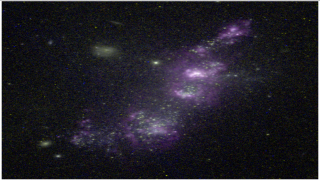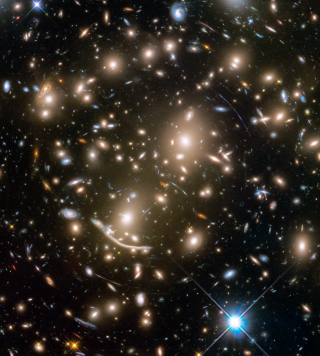Bibcode
Pérez, I.; Aguerri, J. A. L.; Méndez-Abreu, J.
Referencia bibliográfica
Astronomy and Astrophysics, Volume 540, id.A103
Fecha de publicación:
4
2012
Revista
Número de citas
39
Número de citas referidas
35
Descripción
Context. The tumbling pattern of a bar is the main parameter
characterising its dynamics. From numerical simulations, its evolution
since bar formation is tightly linked to the dark halo in which the bar
is formed through dynamical friction and angular momentum exchange.
Observational measurements of the bar pattern speed with redshift can
restrict models of galaxy formation and bar evolution. Aims: We
aim to determine for the first time the bar pattern speed evolution with
redshift based on morphological measurements. Methods: We have
selected a sample of 44 low-inclination ringed galaxies from the SDSS
and COSMOS surveys covering the redshift range 0 < z < 0.8 to
investigate the evolution of the bar pattern speed. We derived
morphological ratios between the deprojected outer ring radius
(Rring) and the bar size (Rbar). This quantity is
related to the parameter ℛ = RCR/Rbar used
for classifiying bars in slow and fast rotators, and allows us to
investigate possible differences with redshift. Results: We
obtain a similar distribution of R at all redshifts. We do not find any
systematic effect that could be forcing this result. Conclusions:
The results obtained here are compatible with the main bulk of the bar
population (~70%) being fast-rotators and with no evolution of the
pattern speed with redshift. We argue that if bars are long-lasting
structures, the results presented here imply that there has not been a
substantial angular momentum exchange between the bar and halo, as
predicted by numerical simulations. In consequence, this might imply
that the discs of these high surface-brightness galaxies are maximal.
The appendix is available in electronic form at http://www.aanda.orgBased on
observations made with the NASA/ESA Hubble Space Telescope, obtained
from the data archive at the Space Telescope Science Institute. STScI is
operated by the Association of Universities for Research in Astronomy,
Inc. under NASA contract NAS 5-26555.
Proyectos relacionados

Grupo de Estudios de Formación Estelar GEFE
El proyecto interno GEFE está enmarcado en el proyecto coordinado, ESTALLIDOS, financiado por el plan nacional desde el año 2001. El ultimo proyecto aprobado es ESTALLIDOS 6.0 (AYA2016- 79724-C4-2-P). En el proyecto GEFE trabajamos en base al caso científico del proyecto ESTALLIDOS 6.0. Los estallidos de formación estelar (Starbursts o SB) son
Casiana
Muñoz Tuñón

Evolución de Galaxias en Cúmulos
Las estructuras en el Universo, a todas las escalas de masa, se han formado de una forma jerárquica y principalmente producidas por fusiones de galaxias. Sin embargo, esta formación jerárquica de las galaxias está modulada por el entorno en el cual se crean y evolucionan. Mientras que las galaxias de campo presentan una evolución pasiva, los
Jairo
Méndez Abreu